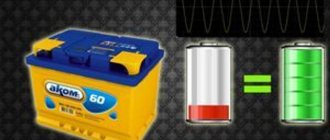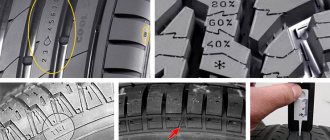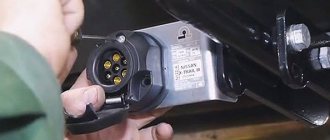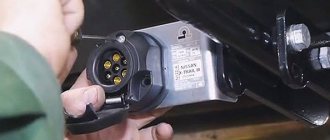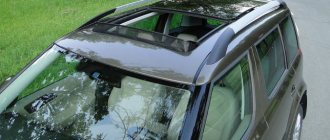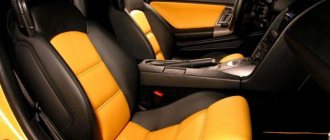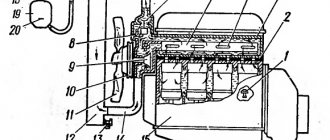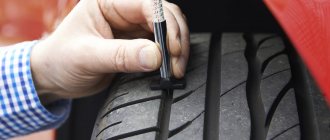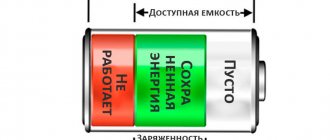All car owners know that any tire gradually wears out. The more wear, the worse the car handles, and its cross-country ability decreases due to a decrease in the traction properties of the tire. This applies not only to winter but also to summer tires. In addition, the owner of a car with an erased pattern will face a fine for a critical reduction in tread depth.
Today we’ll figure out what the minimum permissible tread depth is allowed according to traffic regulations for different types of tires. How to measure it correctly using measuring instruments and improvised means.
Traffic rules requirements
Let's take a look at the Rules of the Road to refresh our memory of the requirements for the minimum permissible tread depth of car tires. I would like to immediately note that these requirements are the same for Russia, Ukraine and the DPR.
Remaining tread depth values below which a fine is imposed:
- For cars and trucks up to 3.5 tons weighing – 1.6 mm;
- For trucks weighing more than 3.5 tons - 1 mm;
- Motorcycles – 0.8 mm;
- Buses with 8 or more passenger seats – 2 mm.
This applies to the operation of summer tires; winter tires have different requirements - the permissible minimum tread depth is at least 4 mm.
The difference between the requirements of traffic rules of the Russian Federation from Ukraine and the DPR
- The minimum tread value for winter tires is the same as for summer tires (Article 31.4.5). The Rules say that in winter, vehicles must be operated only with tires marked in the form of three peaks with a snowflake, the symbols “M+S”, “M&S”, “MS”, that is, on winter tires.
- There is no difference between a studded or friction tire. The standards for minimum tread values are the same.
By the way, the traffic police inspector has every right to independently check the tread height using special measuring devices.
Stage 3. Selection of repair studs for studding winter tires
The stud size should be 1 mm larger than the depth of the seat, for example 12-8-2T mm at a depth of 7 mm, so that part of the insert rises above the tread surface. In case of incorrect measurements and incorrect selection, the tenon may be excessively recessed or, conversely, protrude significantly outward. Both options are unacceptable because they reduce the effectiveness of studding.
Companies that provide tucking services with repair cleats have different modifications of mass-produced products. If the measurements are taken correctly, the studs are selected in accordance with the depth of the hole, the quality of grip will improve and the rubber will last for several more years.
Both measurements must be taken: the technology of re-studding does not involve additional drilling of holes, and the potential for extending the service life of used tires due to studs implies a tread reserve.
These measurements are not mutually exclusive, as modern tires may include:
- a deeper location of the stud set by the manufacturer (below the tread mounting level);
- increasing the depth of the holes under the influence of rocking old tenons;
- The manufacturer has a higher location of the stud (above the tread mounting level).
First of all, the tire service technician must make sure that the tread is suitable for subsequent use. And only then clean the tires and carefully measure the depth of the holes. These actions are characterized by a professional approach, on which the potential mileage of studded tires and your safety depend.
Write to WhatsApp - I am personally ready to answer your questions about tucking
How to measure the depth of a drawing yourself
Use special measuring instruments:
To measure, use a caliper with a depth gauge:
If you don’t have that either, you can use a coin. For residents of Russia you will need a coin with a face value of 2 rubles, for citizens of Ukraine - 10 kopecks:
Based on tire wear indicators
Car tire manufacturers have taken care of their customers. In order not to buy additional measuring instruments, you can monitor tread wear and its remaining depth using wear indicators. They are applied to the working surface of the tire contact with the road.
- Engraving on the tire in the form of numbers from 2 to 8. They indicate the tread depth and the height of the pattern. The wheel gradually wears out, erasing each number, the first to disappear is 8, then 7. If you see 2, it means there is 2 mm of depth left - it’s time to think about buying a new set.
- Wear indicators are hidden in the grooves - rubber partitions and protrusions. If the pattern has worn down to their level, then the tread height is 2 millimeters.
To make it easier to find the location of wear indicators on the tire, manufacturers put a “triangle” on the back side . It represents the arrow “Look here, they are here.” We look up at the working side of the wheel and find rubber protrusions in the grooves.
It is important that if winter tires have maximum wear, then repair studs cannot be installed on them. They won't hold onto it securely. There is a chance of damaging the cord during installation, this is more true for screw studs.
What causes tires to wear out faster?
But the shelf life of tires established by GOSTs and declared by manufacturers can only be relied upon in ideal conditions. Circumstances that bring the tire replacement closer include:
- Improper storage. This can be said if the tires are in an excessively dry, unventilated place in direct sunlight all season, surrounded by corrosive metals, oils, greases and acids. The position of the tires is also important: if they are on rims, the best way to store them is to hang them, and it is better to put tires without rims on the edge. Such conditions are difficult to create on a balcony or in a garage, so the ideal option would be the services of car repair shops with special storage facilities.
- Incorrect pressure in the cylinder. Increased or decreased does not matter: in any case, the load on the tires will not change, but will only be unevenly distributed, reducing the contact patches with the road. In these places, the protector will wear out several times faster than usual.
- Aggressive driving style. Due to driving at high speeds (above 90 km/h) and sharp braking, even the hardest tires wear out noticeably faster.
- Quality of the road surface. Potholes and bumps cause frequent impacts that form dents in the rubber.
- Systematic vehicle overload. A trunk filled to capacity shifts the car’s center of gravity back, and the rear tires are loaded more heavily than the front tires (not to mention the norm), which leads to their rapid wear. And when constantly transporting heavy loads, shock absorbers suffer, also softening the load on the wheels.
Tire storage rules
What affects the tread wear rate?
Finally, in order to adjust the scope of the article to its competitors, I will describe the factors affecting the durability of rubber.
Increased tire pressure. If you do not comply with the requirements of the car manufacturer and maintain excessive pressure in the ramp, then rapid wear of the central part occurs. It was she who had the most grip on the road, and quickly wore it out.
The wheel camber angle is incorrect. If there is increased wear on the outer parts of the tire, one or the other, this means that the wheel alignment needs to be adjusted.
If the tread wears off evenly but quickly , you have an aggressive driving style.
By appearance
This method is the easiest, but it will not provide one hundred percent results. Its essence is a visual inspection of tires. There are a number of factors that unmistakably indicate that they can no longer be used:
- If the rubber shows cuts, cracks and other defects.
- The tread shows uneven wear, when one area is in normal condition, and the other is completely worn down to the cord layer.
- Worn inner part of tires - sometimes it can touch some element of the car and wear off.
- The presence of lumps also indicates that the degree of wear is higher than acceptable.
Workers at service stations and tire shops, and even some motorists, are able to detect the level of tread wear by eye, determining its approximate height.
This is interesting: When do you need to change your car to winter tires?
What does 80% wear mean for used tires?
This is often found in advertisements, where the wear of the pattern is often indicated as a percentage.
Excellent condition for winter 0% - 10 mm . If specified:
- 10% - 9 mm. We take 10 millimeters as 100 percent. 10% of 10 mm is equal to 9 mm;
- 20% - 8 mm, etc.;
If they offer tires with 80% wear, then this is 2 mm - from this rubber you can only make a fence for a front garden or a swan figurine.
For summer tires 0% - 7-8 mm. Therefore, the percentage of wear must be calculated from these values.
How to assess tire wear and suitability for use?
In order to save money, many car enthusiasts prefer to buy used stingrays. In the process of choosing used tires, it is important to correctly determine the wear of the tires - in case of premature failure, no claims will be accepted by the sellers, unless the wheel “shoots” a day after purchase. The ability to correctly assess the degree of wear will also help you prepare in advance for replacing a set of ramps on your own car.
Conclusion
The remaining tire tread depth directly affects road safety. “Bald” tires will not only lead to loss of vehicle controllability and deterioration of the tire’s traction properties, but also to a fine. Traffic regulations are strict in this matter, and any traffic cop can only enjoy making money from a driver.
Be careful and control this parameter yourself. I also told you how to measure it yourself, you know what values are allowed. Now let's move on to fines: in Russia - 500 rubles or a warning (Article of the Administrative Code 12.5 part 1), in Ukraine - 340 hryvnia, in case of repeated violation - deprivation of rights.
In addition to penalties, there is a risk that the insurance company will refuse to pay in the event of an accident. If during the examination it was recorded that the car was driven on “bald” tires, then the chance of getting insurance is reduced to zero.
About uniformity of abrasion
One of the common defects in used rubber is uneven wear, often visible to the naked eye. For example, the tread wear indicator shows a reserve of 3–4 mm, and the “checkers” on the sides have almost worn out.
“Bald patches” and frayed edges are a clear sign of improper use of the stingrays; it is strictly not recommended to use them further.
Uneven abrasion of the working surface is also detected on tires that appear to be quite good. That is why it is necessary to measure the depth of the grooves at 6–10 points - such defects are not visually detected. Based on the measurement results, the following conclusions are drawn:
Despite the acceptable wear of tires with these defects, it is risky to continue using them. In the best case, the rubber will quickly become unusable, in the worst case, it will burst while driving.
